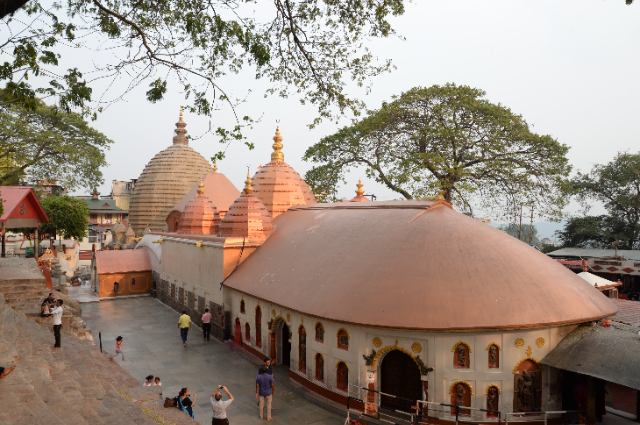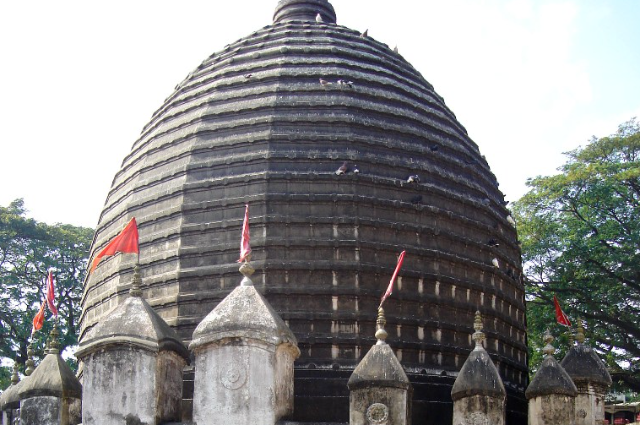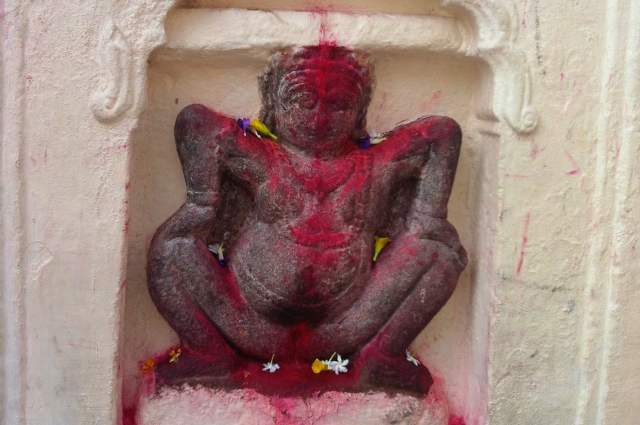Kamakhya Varade Devi Nil Parbat Basini Tva Devi Jagat Mata Yonimudra Namaste.
Being born and brought up in a Hindu(Assamese)household, I always saw my mother offering prayers to God both early in the morning and in the evening. But there were days, when she used to lock our home Puja room and forbid us from going inside. Growing up, I realized that women were forbidden to go to temples during their period. Apart from that, what appeared to me more fascinating was that people were also forbidden from entering temples during the menstruation cycle period of the Goddess. Unlike the periods of normal women, the menstruation period of Goddess is celebrated with pure joy and enthusiasm all over the country. These days are called Ambubachi and have their origin set to the Kamakhya temple of Assam, India.
Origins of the name Kamakhya
Kamakhya is a tantric goddess of Hinduism. In the Kalika Purana, Goddess Kamakhya is described as the most important goddess of the Tantric sect and is identified as Mahamaya. Kamakhya is also called Kameshwari and is a form of Maha Tripura Sundari. The Kalika Purana Yogini Tantra is the basis of the worship of Goddess Kamakhya. She is identified as Kali in the Kalika Purana, Yogini Tantra, and Kamakhya Tantra.
According to legends, Kamakhya is a Sanskrit word consisting of the words “Kama” and “Akhya”. Kama means desire and Akhya means name or identity. Hence, the Kamakhya temple is a symbol of female desire and fertility. According to another legend, goddess Kamakhya fulfills the wants of her devotees and is hence named as the same. Kamakhya Goddess’s blessings can be obtained through good deeds and altruism.
Infrastructure of the Kamakhya Temple
Among the 51 Shakti Peeths in India, the Kamakhya Dham is one of the oldest Shaktipeeth. The main temple is surrounded by ten separate temples namely Kali, Tara, Shorshi, Bhuvaneshwari, Bhairavi, Chinnamasta, Dhumavati, Bagalamukhi, Matangi, and Kamalatmika. These ten separate temples are dedicated to the ten Mahavidya. The Kamakhya Temple is located in the Nilachala Hills of Guwahati, Assam. The main temple is a 10-foot-high rock cave sanctuary with the "Yonipeeth" of Mahamaya and a Shiva Linga. It is a symbol of the sixteenth century. The shrine is covered with a red silk cloth. The silk-clad stone shrines of Mahalakshmi and Mahasaraswati represent two of the ten Mahavidyas, Kamala, and Matangi respectively.
Various Folk Tales related to the formation of Kamakhya temple
According to legends, the Hills on which the Kamakhya Temple is located are Mahadev himself. The mountain turns blue when the vagina of Sati falls on it. Hence the name of this mountain is “Nilachal”. The temple of Goddess Kamakhya is located in the Nilachal Hills and is the most famous and influential temple of Assam. Kamakhya, the center of Shakti worship, has had an important influence on both the political and religious aspects of the history of Assam since ancient times. According to folklore, the Kamakhya Temple is believed to have been built by Narakasura and according to history by the Koch kings Maharaja Biswa Singh and his sons Naranarayan and Chilarai. The Koch Maharaja Biswa Singh recovered the Kamakhya Peeth located on the Nilachala and built the Kamakhya Temple there. Also, it is said that Nakasura was the first to build the temple of this shrine.
Later, the shrine fell underground and the inhabitants of the mountain started worshipping it. Once, Biswa Singh and Shishya Singh were separated from their soldiers during a night expedition and lost their way and finally reached the Nilachal Hills. Next to the fallen pedestal, an old woman sitting at the root of a tree hears everything and offers worship for reconciliation with the separated army. After this, the king's wish was fulfilled. The king was amazed at the greatness of the place and decided to build a golden temple there. Excavations uncovered the remains of an ancient temple. The king built a new brick temple on top of the ruins. According to legend, he gave a Rati of gold to each brick of the temple. In 1553, the Muslim general Kalapahar destroyed the Kamakhya Temple during his invasion of Kamrup. The temple was later rebuilt by the Koch king Maharaja Naranarayan, son of Biswa Singh, and his brother Chilarai.
It is noteworthy that the story of the sacrifice of Shiva's consort Sati is also associated with the beginning of the worship of Shakti in the Nilachal Hills. This legend is contained in the Kalika Purana about the origin of the Kamakhya Temple. The Kalika Purana states that Sati, the daughter of Daksha, married Mahadeva without her father's consent. Daksha could not look at Mahadeva as a cocoon without property. Once he (Daksha) organized a sacrifice (Hawan in Hindi). But he did not invite his son-in-law. However, Sati arrived at the sacrificial site without being invited. Daksha's anger reached the tip of his hair.
He began to curse Mahadeva. Unable to bear the disgrace and insult of her husband, Sati died at the sacrificial site. Seeing this Mahadev carried the body on his shoulders and began to travel the world. Then, slowly different parts of the body started falling to different parts of the world. Legend has it that the parts of Sati's body were used to create shrines. A pilgrimage site was built there. The vagina of Sati fell on the Nilachala Hills and the temple of Goddess Kamakhya was established there.
According to the Bhagavad Purana, Narakasura or Narak was the son of Bhumi (the goddess of soil) and Varaha (the third incarnation of Vishnu). The legend of Narakasura is important for the history of Assam. There are several dynasties of the Kamrup rule that are known to have descended from Narakasura. There is a hill called Narakasura to the south of Guwahati. Narak's mother Bhumi asked Vishnu for a long life and strength for her son Narakasura. Vishnu fulfilled this boon and also taught Narakasura to worship Goddess Kamakhya. His name is also associated with the goddess Shakti and the place of worship, Kamakhya. The legend of Narakasura is most widely described in the Kalika Purana, an Upa-Purana written in Assam in the 10th century.
The Pragajyotishadhipati was the Narakasura of the Kirat dynasty. He is a devotee of Goddess Kamakhya. He was the first to establish this temple on the Nilachal Hills. Legend has it that Narakasura once saw the goddess and was fascinated by her heavenly beauty and proposed to her. The goddess informs Narakasura that marriage between gods and human beings is impossible. But to get rid of the stubborn attitude of Narakasura the goddess made up an idea. The goddess told Narakasura that if he could build a stone staircase from the south of the Nilachala to the temple within one night for the convenience of the visitors, she would marry Narakasura. The goddess thought this would never be possible. But Narakasura was about to finish building the stairs before the end of the night. The goddess saw that things were getting difficult. Her idea was proved wrong. So she decided to resort to conspiracy. And as the goddess commanded, the hen called before the end of the night. Then the goddess told Narakasura that night had come to an end as the chicken had called. Narakasura could not fulfill the conditions. Thus, the goddess was saved from Narakasura. But later, when Narakasura learned the truth and the conspiracy of the goddess, he chased the chicken in anger and cut the magical chicken in two at the present place called Kukura Kata (Kukura means chicken in Assamese). The unfinished staircase, which is said to have been built by Narakasura overnight, is known as the "Mekhela-Ujuwa" road.
After this incident, Narak refused to allow Bashishta Muni to worship at the Kamakhya Temple and the sage cursed Narak and the goddess that the wishes of those who worship at the temple would not be fulfilled. However, with the intervention of Shiva, the curse was limited to three years. Therefore, Narakasura came into bad terms with Vishnu and Kamakhya. Gradually, Narakasura began to conflict with the gods. After conquering all the kingdoms of the earth, Narakasura invaded the kingdom of heaven and Indra fled from the kingdom of heaven in fear of Narakasura. Narak then stole Devi Aditi's gold earrings and kidnapped 16,000 women. Narak caused terror among the gods and goddesses in heaven. In desperation, all the gods, including Indra, went to Vishnu and prayed for the destruction of Narakasura. Vishnu assured the gods that he will accomplish the task in his Krishna incarnation. Narak had already received a long life according to the boon given to Bhudevi by Vishnu.
Later, Aditi tells Krishna's wife Satyabhama about the ill-fame of Narakasura and Satyabhama persuades Krishna to fight against him. The atrocities of Narak increased to such an extent that Krishna, accompanied by Satyabhama, the incarnation of the goddess Bhu, invaded the kingdom of Narakasura on Garuda, killed the commander of Narakasura's army, "Mura", and finally killed Narakasura with the Sudarshan Chakra. He rescued Aditi's golden earrings and 16,000 kidnapped women and handed over the throne of Pragajyotispur to Bhagadatta, the son of Narakasura. He surrendered the throne of Pragjyotishpur. Before his death, Narakasura requested mother Satyabhama to celebrate his death with colorful lights. Therefore, this day, the day before Diwali, is celebrated as Narak Chaturdashi.
Folk Tales Related to Ambubachi
The word Ambubachi comes from the Sanskrit words Ambu and Bachi. Ambu means "water" and "bachi" means to live. That is, to live in water. According to astrology, "Yasmin bare sahasranshu yatakale mithunam brajet. Ambubachi bhabe nnitm punahsthakal- barayah.” That is, from the time when the Sun moves to the first position of the wet constellation in Gemini on the day of the month of Ahar, the mother Earth and the original energy Mahamaya becomes menstrual or Ambubachi begins. " Tavatakalobadhi- twenty-three days". That is the position of Ambubachi for three days from the time of the Sun's transit to Gemini. According to the Assamese calendar, this period is celebrated as "Ambubachi" for three days from the 7th of the Aasad (आषाढ) month. It means "the goddess lives in the water".
In Hinduism, menstruation has been taken very seriously since ancient times. The process of menstruation is a symbol of "fertile energy". A girl's first menstrual period means that she is fertile. According to Hinduism, this process is not only for a girl in human form but in Hinduism, nature or the earth in whose bosom or shadow we are nurtured also menstruates once a year. Hence, the menstruation of the goddess Nature(Kamakhya) also has a season once a year. This is the time when the goddess becomes menstruating and is called "Ambubachi". Ambubachi is celebrated with great devotion and joy at Sri Sri Maa Kamakhya Dham in Assam and all over the world. All temples in India are closed for these three days. It is significant that the divine energies perform their duties very faithfully throughout the year. They bless us. Ambubachi is a time when the goddess rests or is given rest.
According to the Assamese calendar, Ambubachi starts on the 7th day of the month of Ahar. This is the beginning of the rainy season. During this time, the soil is protected from the hot sun. The soil is fertile. Rain increases the water level in the mother's womb. And the earth is softened and overflowed. The earth becomes fertile. The crops sprout in the earth. Just like a pregnant woman.
The goddess will also spend these three days in the rising waters at Sri Sri Kamakhya Dham. The goddess is dressed in red. Red is a symbol of strength. The energy that every woman has, her body loses energy every month. This is why women have fertile energy. The color red, the symbol of power, is offered to the goddess. Red is also a symbol of "Raj" qualities and creativity. Therefore, this color of the goddess is very important in Hinduism and for the devotees of the goddess.
Celebrating Ambubachi at home
On the first day of Ambubachi, the idol of the goddess should be covered with a new red cloth before the appointed time of instinct. The curtains of the worship room should be pulled or the doors should be closed. This is done to give rest to the goddess during the menstrual days. These days entry into the Puja room is prohibited. Every evening during the seasonal days, fruits and water should be offered to the goddess from outside the puja room. They should also perform Aarti in general. The devotees should offer the mantra given below to Goddess Kamkakhya :
“Kamakhya Kamasampanam Kameswarim Harpriam.
Kamanam dehi me nityam
Kameswarim Namastute.
Kamakhya Varade Devi Nil Parbat Basini Tva Devi Jagat Mata Yonimudra Namaste”
The Impact of Kamakhya Temple in Present-day Assam
Today, the Kamakhya Temple is not only the most important Shakti Shrine in Assam, but also a key symbol of Assamese culture, heritage, and economy. Situated on the Nilachal Hills, it overlooks the city of Guwahati and represents religious devotion and cultural pride. Pilgrims from all over India and abroad visit the temple year-round, with numbers peaking during the Ambubachi Mela in June. The temple also attracts sadhus, tantric, spiritual seekers, and tourists curious about its unique rituals. The presence of ten Mahavidya shrines in the temple highlights Kamakhya as a living center of Shakta-Tantric traditions rarely seen so thoroughly anywhere else in India.
Kamakhya is an essential part of Assam and Assamese identity. Songs, dances, paintings, and literature of Assam often celebrate the goddess. Festivals and fairs at Kamakhya reflect the blended traditions of the region, where tribal customs, Hinduism, and Tantric practices coexist peacefully.
Commercialization of Kamakhya Temple
In recent decades, Kamakhya has seen rising commercialization, a natural outcome of its popularity. On one hand, this has greatly benefited Assam. For instance, Kamakhya is among Assam’s top tourist destinations. Thousands of pilgrims and tourists visiting each month fuel the hospitality sector, including hotels, guesthouses, restaurants, and transport services. Also, local people find jobs as priests, temple staff, tour guides, drivers, vendors, and small businesses catering to pilgrims. The visitors even buy Assamese handicrafts, traditional clothes like Mekhela-Chador, bamboo products, and souvenirs, giving artisans a chance of increasing business. Donations to temples, festival tickets, etc., bring in money for local development and temple upkeep.
Commercialization does, however, provide certain difficulties. The ecology and the genuine spiritual experience are impacted by overcrowding, uncontrolled construction near the Nilachal Hills, traffic jams, waste management problems, and growing costs in the temple region. Better road access, cleaner amenities, and regulated pilgrim accommodations are just a few of the continuous efforts to strike a balance between development and preservation.
Kamakhya as a Spiritual Brand
In today's time, Assam uses Kamakhya as a "Spiritual Brand." It appears in travel advertisements both domestically and abroad. Its Tantric legacy is highlighted in a number of documentaries and studies. In the Northeast, Kamakhya is either the beginning or finish of spiritual tourist circuits. As their cultural ambassador and spiritual mother, Kamakhya is revered by the Assamese people. As a place of mysticism, faith, and long-standing customs, Assam is more widely recognized thanks to the temple's reputation.
The beliefs of Assamese society around menstruation, fertility, and feminine authority have been influenced by Kamakhya rituals and myths. In particular, the Ambubachi Mela has developed into a forum for talking about menstrual health and dispelling associated taboos. The holiday is now used by health departments and NGOs to spread awareness about women's health and provide sanitary napkins.
Conclusion
As a living institution that reflects Assam's faith, history, economy, and cultural pride, Kamakhya is much more than just a temple. The local economy has undoubtedly benefited from commercialization, but maintaining the temple's spiritual core, ecological harmony, and cultural authenticity is still a constant duty. Kamakhya serves as a potent reminder that religion, business, and culture can and should all live peacefully.



